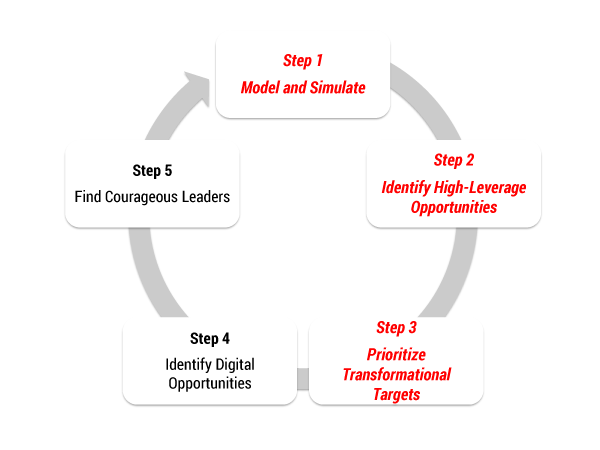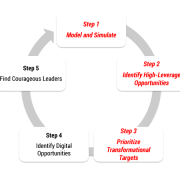BT & DTS EXECUTIVE UPDATE VOL. 19, NO. 7

In the November-December 2015 issue of Cutter IT Journal (CITJ), I shared “Five Steps to Digital Transformation.” This Executive Update picks up where that discussion left off and dives deeper into the front end of the transformation process.
A Quick Refresher
What is digital transformation (DT)? Wikipedia describes digital transformation as:
Digital transformation refers to the changes associated with the application of digital technology in all aspects of human society. Digital transformation may be thought [of] as the third stage of embracing digital technologies: digital competence → digital literacy → digital transformation…. The transformation stage means that digital usages inherently enable new types of innovation and creativity in a particular domain, rather than simply enhance and support the traditional methods….
Digital transformation affects both individual businesses and whole segments of the society, such as government, mass communications, art, medicine or science.
Figure 1 presents the roadmap I discussed in CITJ. It also highlights Steps 1, 2, and 3 of the digital transformation (DT) process, which is the focus of this Update.

Real Careful Modeling
As I said in the CITJ article:
If you cannot model your existing business processes and your overall business model, you cannot transform your business.… Run the hypothetical models over and over again, changing the variables to see which combinations are likely to produce transformational outcomes.…
BPM and simulation require subject matter expertise, discipline, tools, and objectivity, which is why external consultants are best suited to modeling and simulation.…
BPM efforts are also expensive, time-consuming, and iterative, so don’t expect overnight transformation results, or even a transformation plan, until all your business processes are identified, described, catalogued, and simulated.…
It’s essential that powerful modeling tools be implemented.… They must be capable of modeling, simulation, and outcome analytics.1
Process modeling is organizationally challenging. Yes, there are powerful methods and tools to assist you, there are experienced consultants who will work with you, and there are sincere (and insincere) internal champions of modeling efforts. But there are also political land mines everywhere.
Begin the modeling process with a “consensus test,” which identifies process areas — like supply chain or inventory management — where there’s relative consensus about inefficiencies. CRM could be another area, or even billing. Do not model processes that are measurably “OK,” or processes that the competition is modeling — unless their problems are also your problems.
Next, measure the internal “embarrassment quotient.” Who will be embarrassed by the results of the consensus test? Relative consensus about failed or broken processes notwithstanding, when a process is listed as officially failed or broken — and therefore the target of formal modeling — someone will be embarrassed. Make sure that any reputational damage to individuals and teams is managed and make sure that “accountability” is not used as a weapon to crush political enemies: be extremely careful if the broken process belongs to a member of the senior management team.
One way to accomplish this part of this goal is to emphasize the quantitative-empirical over the qualitative-subjective. “The data is the data” is a good phrase to repeat, while always avoiding phrases like, “It’s all Tom’s fault!” Regardless of how hard you try to avoid innuendos and implications, Tom may still get blamed for making the transformational list. You have to deal with Tom — and his enemies (that your modeling work has empowered).
Another way to accomplish the modeling goal is to emphasize subject matter expertise. Ensure that the modeling team is substantively credible beyond reproach. This is not the time to hire horizontal consultants fresh out of graduate school to lecture the team on Porter’s Five Forces. Instead, hire consultants with deep experience in your vertical industry who can hold their own with long-standing, well-respected industry veterans — and with anyone in your company that claims to know it all.
Begin the modeling process with simple models about which there is relatively little disagreement. For example, begin the BPM process with straightforward descriptive models of the processes in question, such as inventory management, CRM, sales, or marketing. These descriptive models should be industry-validated before turning to the prescriptive models intended to improve the failed/broken processes under scrutiny. While it will be challenging to forge agreement about how current processes actually work, it will be much more difficult to achieve consensus about how the failed/broken process should be remodeled: the pivot from descriptive to prescriptive modeling is the most challenging part of the BPM process. Anticipate it, manage it, and optimize it — or the whole BPM exercise will collapse.
Tools are always important. There are many tools out there that will do the job. Be sure to select a tool that enables quick answers to what-if questions and one that empirically describes, explains, and prescribes outcomes. Do not select an overly complicated tool with features that will never be used, and make sure the displays the tools generate are easily comprehensible to BPM novices. If someone says, “I have no idea what this display is telling me,” find another tool.
Real Leveraging → Prioritization
As I said in my CITJ article:
Engaging in a serious, formal BPM process followed by detailed simulations of alternative processes, there’s an opportunity to identify — with empirical evidence — the processes likely to have greatest transformational impact.…
Do this by collecting empirical data about the costs and benefits of the existing processes and models and performing what-if simulations of alternative improvements.… [But] if simulation results fall short of measurable, meaningful transformation, stop testing. Not every company, process, or business model will benefit from transformation.
Forging consensus about which processes are failing or broken and which improved ones can generate the greatest impact requires every soft skill you can find. But it also requires as much real data as possible. This is the middle ground that every transformation manager must find. But at the end of the day, the prioritization process is political, though informed — but not decided — by BPM data.
I remember well a large BPM project I helped implement at Shire Pharmaceuticals. There was a lot of consensus about the approach and ultimate value of BPM, but when the results were compiled, there was nothing short of disinterest among the stakeholders. The processes we modeled were absolutely broken, but not so much as to threaten the company’s primary revenue stream. Even the president of the business unit most in need of “reform” supported the BPM project through a series of politically correct interviews and roundtables. We were all excited that the president was participating personally in our effort to improve her processes! Little did we know that despite her agreeing that her processes were absolutely broken, she had no intention of ever changing anything. She happily participated because she understood that improving even broken processes would have little impact on the price of the stock, the size of the bonuses, or the long-term viability of the business. So rather than upset any apple carts, she punted.
So what to do?
Start small by gathering as much support as possible. Ensure that everyone keeps the transformational goal in sight. As I said in CITJ:
Is it to save money, increase market share, increase profitability, retain employees, disrupt a company and industry, or … what? You must know where you’re going to get there. You also need to reality-check your prioritized objectives according to budget, time, talent, and market constraints: use outside consultants who have no vested financial interests in their recommendations to screen transformation alternatives. Never rely on internal professionals to adopt or reject transformational options. Their recommendations will be influenced by too many vested human and financial interests. From the options list, identify and integrate specific transformation projects to be led by outsiders: insiders may sabotage transformation processes.
Said differently, find a savvy HR professional, perhaps a psychiatrist, and maybe even a soothsayer to help you manage the BPM process. Watch for land mines and backstabbers while you find and value legitimate partners. Emphasize wherever and whenever you can the quantitative-empirical results of your BPM analyses.
Keep IT All Real
You still need to match all this with the right digital technologies and find senior leadership that will stay with your BPM projects before, during, and after good and bad results. As I said in CITJ:
The number of corporate executives, especially in public companies, who really want to transform their companies is relatively small. The major exception to this rule is the strong correlation between the desire (D) for transformation and falling revenue and profits (FP), or D + FP = DT.
Digital transformation … is slow and iterative: industries do not transform themselves overnight.
Steps 1, 2, and 3 of the transformation process must be implemented carefully and thoughtfully. If you fail in the beginning, you will fail at the end.




